|
Vegetable Garden Pests, Common Garden Pests to be on the Lookout for When Starting a Vegetable GardenVegetable garden pests are under the impression that if you grow it…they’ll eat it. But to be fair…it’s just their instincts. They instinctively follow the food. However a beautiful vegetable garden that becomes over-run by common garden pests will perform poorly. And the harvest will be disappointing. In other words… Your hard work, effort and money that you pumped into this backyard project would be wasted. That’s only if you don’t keep an eye out for these vegetable garden pests. Now before you begin stereotyping…I must inform you that not every garden insect you see is a pest. In fact…some bugs (like the ladybug) actually feed on vegetable garden pests. And these types of beneficial insects should be encouraged when building a vegetable garden. The insects that you should be cautious about are those that feed on your vegetables and carry diseases. Here's a List of 10 Vegetable Garden PestsAphids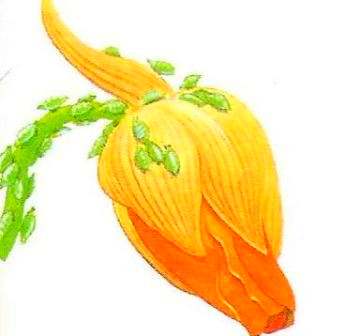 Aphids are soft and round in shape. They usually grow to either the size of a pinhead or a little larger than the size of the head of a match stick. They also vary in color. Some are black, white, pink or pale green. Aphids grow in clusters and feed upon the juices of the plants and vegetables. They also transmit diseases to crops. If they’re present in your garden you can spray them off with blast of water from your garden hose. Then you can install floating rows to protect the crop from further invasion. See insects control for more information on floating rows. Cabbage LoopersThese are caterpillars that are greenish in color. They feed upon cabbage and other leafy vegetables.  If cabbage loopers are a problem in your garden then introduce the trichogramma wasp. These wasps feed upon the eggs laid by the loopers. And as for those that have already developed into caterpillars…you can hand pick them and then install floating rows. Cabbage Root MaggotsThese are the larva of the cabbage fly. These flies lay their eggs in the soil close to the roots of the cabbages plant (and also plants related to the cabbage). When these maggots are hatched from the eggs…they begin feeding upon the roots of the plants. This causes the cabbage plant to become stunted in its growth and development. To prevent cabbage root maggots, use floating rows to cover the plants. If the fly is denied access to the soil next to the cabbage…then they’ll move on to another garden. You can also introduce nematodes. Nematodes are predators of the root maggot. Introducing them into the garden can greatly reduce the maggot population. Colorado Potato BeetleThese beetles are yellow and black striped and there larva is reddish brown in color. Both adult and larva feed upon the leaves of potatoes, tomatoes and egg plant. They can be handpicked and infected plants can be destroyed. You can also use an organic insecticide containing pyrethrins if you want. However I’m very reluctant to use these. That’s because insecticides not only kill vegetable garden pests but also the beneficial insects. See insect control for more info on organic pesticides. Cucumber Beetles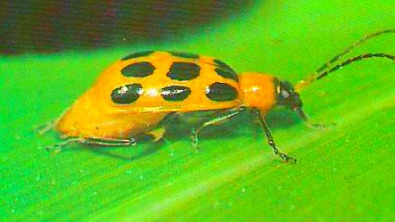 These beetles are bad news for your…
The cucumber beetle feeds on all parts of these vegetables and transmits diseases such as bacterial wilt which harms the cucumber especially. To prevent them you can use floating rows. But if they’ve already infiltrated the garden, then remove and destroy infected plants. You can also release nematodes into the garden. These nematodes feed upon the beetles. And finally… If all else fails…you can then resort to insecticidal sprays containing pyrethrins. CutwormsCutworms are dull brownish colored caterpillars that live in soils. They attack plants when new shoots are just coming out of the ground. Cutworms are also found higher up on established plants feeding upon the leaves. 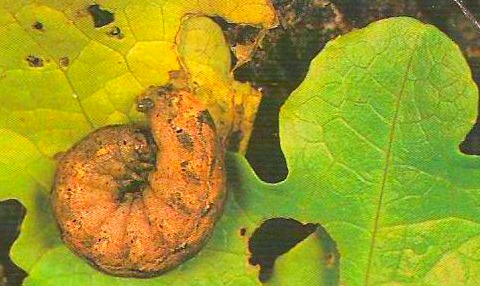 To get rid of cutworms you can clear and till the soil. The tilling crushes and slices the worms. And… To lighten the work of tilling why not rent a rotavator. The rotavator is a mini tiller that makes digging up the soil quick and easy. You can also use collars around the base of new shoots. This prevents the cutworm from reaching the plant. And finally, our trusty friend…the nematodes also kills cutworms as well. They are one of the most beneficial insects to have in a garden. Flea Beetle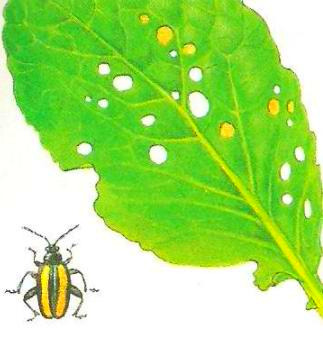 These beetles get their name because they jump about like fleas. They’re usually small, oval shaped and blue-black in color although some of them may be brown or bronze. Flea beetles feed upon the leaves of plants. And if your crops are young crops…then the beetles can totally destroy them, especially if that crop is the egg plant. Older plants, however, may stand a chance against them. Manage your vegetable garden against these vegetable garden pests by removing the dead or damaged plants. You can also till the soil in fall months. Use a mini tiller or a rotavator to turn over the soil. Additionally you can use floating rows to cover your plants. And if that doesn’t work…then you can spray the vegetable garden with insecticides like neem and pyrethrins. GrasshopperGrasshoppers are also called locust and may be green, yellow or brown. 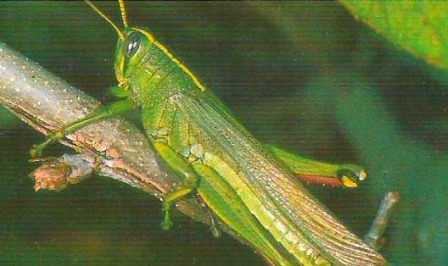 They feed mainly on the leaves of the plants. And can cause havoc to your garden during an outbreak. What you can do to fight against them is to till the soil in the…
This destroys the eggs that grasshoppers lay during the colder months. You could also introduce a predator called Nosema Locustae. These insects feed only on grasshoppers and won’t bother the other beneficial insects. MitesMites (a relative of the spider) feed on the juices of the plants. This causes the leaves to dry out and die. 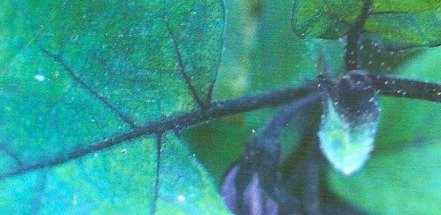 You hose off the mites off of the plants. Or… you can release predatory mites to feed upon them. You can also spray with insecticidal soap. WhitefliesWhiteflies live together in clusters. And suck the juices out of plants. 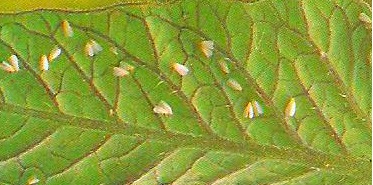 One way of identifying if your plant is under attack by vegetable garden pests, is by the development of yellow spots on leaves. Leaves that are curling and turning brown is also an indication. Getting rid of these vegetable garden pests... You can use sticky yellow cards (similar to the sticky paper used to trap flies in the house). 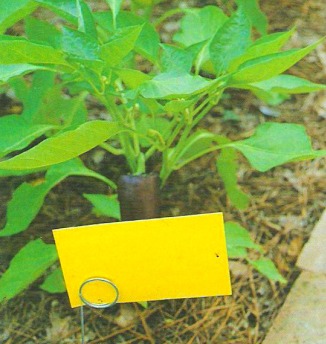 Or... insecticidal soap to get rid of whiteflies.
Vegetable Garden Pests are not limited to Garden Insects OnlyIf you’re into urban gardening (that is growing a garden in the city) then insects may be your number group of pests. However… if your backyard vegetable garden is in the suburbs or the countryside… Then you may have to consider vegetable garden pests such as…
 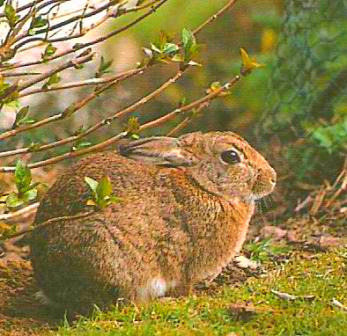 Protection against BirdsBirds can be useful if they’re feeding on insect pests, but if they turn their attention on the seedling and transplants in your garden… Then they themselves are pests. To protect vegetables against them…use floating rows as a barrier. You can also use netting to cover the crops as well. Placing a bird bath surrounded by berries and fruit trees a few meters from the vegetable garden can also lure birds away. Protection against DeerA deer can eat down your entire garden in just a few hours. Can you imagine that? You backyard project that took months to build can be destroyed by one deer in 2 hours. That’s why you must guard against them with a vegetable garden fence. The fence design should be high enough so that a deer cannot leap over. One that is 8 feet high is ideal. You can also consider the parallel fencing technique. This is where you’re putting up fence rails within an existing fence. In other words…it’s a fence within a fence. This technique prevents deer from leaping over and across to get into the garden. Parallel fence rails should be 4 to 5 feet apart in order to be effective. Guarding against Gophers and MolesGophers and moles will both tunnel into your garden…but they’re both after different things. Gophers are after the roots of your plant. It’s a source of food. Thus if you notice that your plants are wilting… And… Crops that are harvested have little or no roots, then you’ve got gophers. Moles on the other hand feed upon worms and grubs. However, their tunneling uproots young plants. Therefore they cause havoc in the garden. So the best way to guard against them is by building raised beds. This way you’re taking the vegetables out of the ground. This makes it impossible for the gophers and moles to reach them. You can also line the sides and bottom of planting holes with a ½-inch mesh. This barricades the roots and provides protection. Here’s a tip… If your garden is a beginner vegetable garden… Why not inquire from an existing gardener if gophers and moles are problems in your area. Their response will determine if you should plant directly into the soil… Or…go with a raised garden bed. It’ll save a lot of time and money. Dealing with the Rabbits PestsJust like deer… rabbits will eat you entire garden in a few hours. And likewise…fencing the garden can help. A 2 feet fence is ideal to prevent rabbits from leaping over and into the garden. But ensure that if it’s a wire fence the mesh is small enough to stop them from climbing through. However, like gophers and moles…rabbits can tunnel underground as well. Thus run the fence at least 6 inches underground. So there we go. We’ve covered vegetable garden pests in some detail. We’ve identified some of the insects as well as the animal pests. We also discussed some ways to guard against them. Remember that it’s wise to conduct some research in your area before starting a vegetable garden. Speak to existing gardeners to get an idea of the vegetable garden pests that affect crops in your community. It’ll help you plan and forecast.
|









